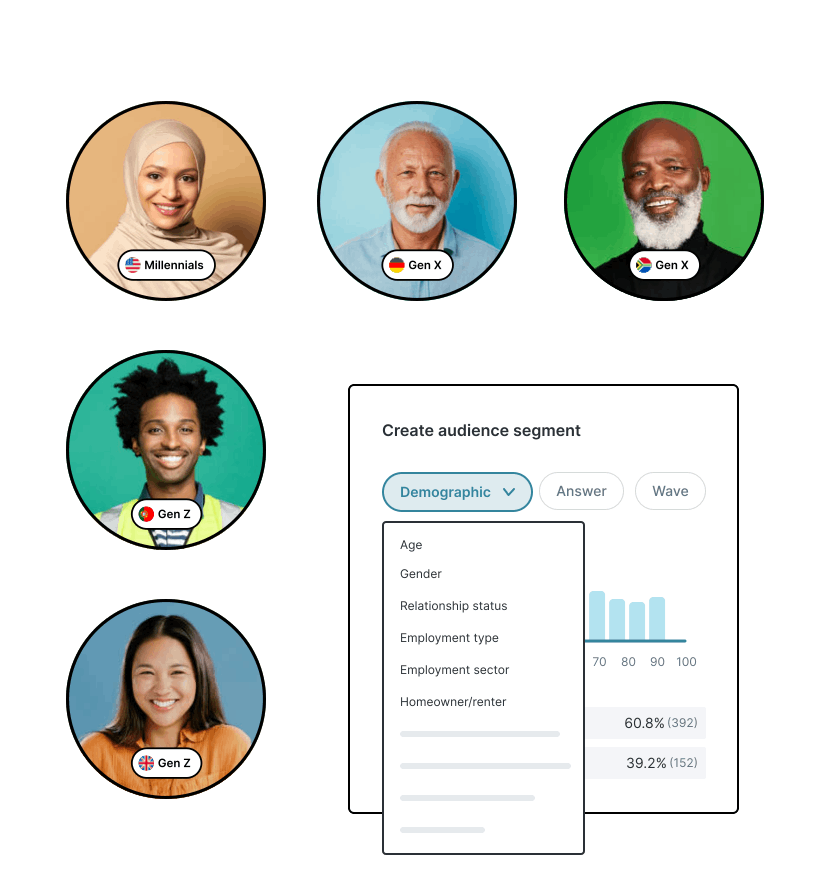The qualitative market research guide: actionable methods for best results

If you’re thinking about skipping qualitative market research and just going with your gut, this article is a must-read.
While some brands and products in the past have won big based on someone’s intuition, it certainly isn’t a reliable recipe for success — because many more who’ve invested based on an instinct, have failed. Hard.
That’s why we want to highlight the importance and value of qualitative market research. It’s what explains why people pick one product over another that seems just as good.
Qualitative research digs into the nuances, offering insights that can significantly impact your marketing approach and product development. Here we’ll show you exactly how you can turn it into your secret weapon.
What is qualitative market research?
Qualitative market research goes straight to the core of your customer’s thoughts and feelings. It’s not just about how many people clicked or bought, but why they did it, or even why they didn’t.
This kind of research lets you in on the stories behind the statistics, giving you a more in-depth understanding of your target audience’s behaviors, perceptions and motivations. And with this rich insights and data, you can tailor your products and marketing strategies to truly resonate with your audience.
Here’s a quick rundown of the types of market research out there:
- Quantitative research: Deals with numbers and measurable forms.
- Qualitative research: Focuses on understanding the quality of consumer interactions and thoughts.
- Mixed methods: Combines both quantitative and qualitative research.
It’s good to know qualitative and quantitative research make a great pair – it helps you give context to numbers, and vice versa. And it’s good to know when you could run qualitative research:
- Before your quantitative research? If you’re grasping for ideas and inspiration, qualitative market research can be a great source. Your respondents will often flag issues or make suggestions that you and your team might never have thought of. And for extra peace of mind, you can follow-up your qualitative research with quantitative studies to make sure that inspo is truly representative.
- After your quantitative research? Often teams will have run quantitative studies and spotted threads they’d like to pull at and see whether there’s more to learn. This is where qualitative market research comes in – it can add flavor and context to your quant data. And it can be a great way to personalize your data for internal or client signoff.
Of course, there are different ways of gathering qualitative data. So when we talk qualitative research, these are the main methods you’ll come across:
- Ethnographic research: observing your customers in their natural environment, seeing how they live, work, and play.
- Narrative research: collecting stories from individuals to better understand their experiences.
- Phenomenological research: used to understand common experiences among a group of people, researching shared perceptions.
- Grounded theory: developing a theory based on the data you collect, starting with the data and working towards a theory.
- Action research: a collaborative approach, working with groups to identify solutions to problems and implement changes.
Each of these approaches gives you unique insights into the minds and lives of your customers, helping you make more informed decisions that can drive your brand forward.
If you want to know more about the ins and outs of different research types, check out our blog about the difference between quantitative vs qualitative research, and here’s a quick video summary to get you started…
The ethics of qualitative market research
While it’s not exactly mind reading, qualitative market research does touch more on personal thoughts and opinions than, for instance, quantitative research does. That means it requires trust – and that’s where ethics come into play. Here’s what keeping it ethical looks like:
- Participant confidentiality: Keeping the identities of your participants under wraps is a non-negotiable.
- Informed consent: Participants need to know what they’re getting into, how their insights will be used, and how they can change their involvement.
- Sensitive information: Any data that could be considered sensitive deserves extra protection and consideration.
Data isn’t high quality when it isn’t ethical, and vice versa. If your respondents don’t feel that their answers will be handled with care, they might not answer honestly – if at all.
At Attest, we’re all about making sure your insights are built on a solid foundation of excellent data quality, trust and transparency – for both you and your respondents.
Because what’s the point of qualitative research if you can’t trust the results? Check out how we assure data quality that you can rely on.
How to conduct qualitative market research
The research you do should be the foundation of the actions that follow — don’t just conduct research for the sake of it. Choosing the right qualitative research methods and tools is crucial, but there’s more to it.
By following the steps below, you’ll not only gather rich, qualitative data but also pave the way for meaningful changes in your product development, marketing strategy, and overall brand experience.
1. Create a research plan
When you conduct qualitative research, or any kind really, the steps you take should be based on your research objectives, and related to the actual changes you might be making. This is what makes market research crucial for marketing experts: it shows you which actions to take, instead of just doing creative guesswork.
First, decide on your qualitative research methods—will you go for surveys, focus groups, or a mix? Define clear objectives. What do you want to learn? Keep in mind how to balance your research approach: you can opt for direct exploration for fresh insights, monadic testing for focused feedback, sequential monadic testing for comparative insights, or discrete choice testing to understand preferences. Each method has its place, and combining them strategically can offer a fuller picture of your market.
Next up, consider your sampling methods. Who are your ideal participants? Where can you find them? (Hint: we help you with this!)
Once you know what to ask and who you’ll be speaking to, it’s time to start crafting your survey — and using our templates makes that even easier. Take your pick and start tweaking.
The final step of your research plan, is choosing which qualitative market research tool to choose for. The steps below give you some guidance on what to look for.
2. Recruit the right participants
The power of qualitative research lies not in the most fancy tools, but in the quality of your participants.
You’re looking for individuals who reflect your target audience or represent a new market you’re exploring. The key is to ensure diversity and relevance to get a comprehensive understanding of consumer behavior and opinions. Read more about how we help you get in touch with the right people — picking from an audience of 150+ million people in 59 markets spread across the globe.
3. Conduct interviews, surveys or focus group research
Jumping into your audience’s world, interviews, surveys, and focus groups are essential tools in your research kit. But how do these qualitative market research methods add value?
- One-on-one interviews offer a closer look into what your consumers are thinking and feeling, providing valuable insights into their personal experiences and expectations. This intimate format fosters detailed conversations that can uncover deep-seated motivations and stories.
- Surveys allow for a broad reach, enabling you to connect with a wide audience very quickly to collect various data points. This method is great for identifying trends, preferences and behaviors on a larger scale.
- Focus groups, on the other hand, bring a unique dynamic. In these sessions, participants’ interactions can generate new insights and perspectives, offering a diverse view of your product or service. This collaborative environment encourages research participants to build on each other’s ideas, revealing insights that might not emerge in individual settings.
Remember: you don’t have to limit yourself to only one option – but pick a mix that works best for your research goals, and your audience. Their participation is key here.
4. Conduct observational research (optional)
Now this is optional, but if you want an extra layer to your research process, observational research is a great supplement to your qualitative study.
Instead of just hearing what your target audience is thinking, you are going to see how it affects their actions, by tracking how they interact with your products, navigate your stores or use your website.
Watching from a distance, you might discover that consumers use your product in ways you hadn’t imagined. It might also clarify some statements you heard or uncovered during the survey or interview phase – observational research can unearth gems of insights that are invisible in one-on-one conversations or online focus groups.
Of course, this approach requires patience and a non-intrusive stance. You don’t want to influence people, and it’s not easy to do it at a large scale – but in some scenarios adding an extra research method like this certainly gives extra depth to your findings.
5. Analyze your research data
With data in hand, it’s time to sift through the stories and sentiments to find patterns and themes. Qualitative data analysis can be complex, but it’s where you begin to understand the ‘why’ behind the behaviors that drive your customers’ choices.
Don’t just use qualitative insights to confirm your hopes and beliefs. Actively look for commonalities, differences, and surprising insights that can guide your strategy.
6. Report and communicate findings to key stakeholders
This is the springboard to action. If you can package your findings in a way that resonates with your team, management, or clients, you’re one step closer to meaningful and impactful changes.
Clear, compelling reporting translates your research into actionable insights – and our tool helps you get them.
Share stories, highlight key themes, and suggest next steps. Make your qualitative research findings a cornerstone for your decision-making and strategy development.
What are the applications of qualitative market research?
You can use qualitative market research for practically every aspect of your business. But let’s highlight some of the most popular applications first:
- Product development: Before your product hits the shelves or the digital marketplace, qualitative research helps you tune into what your customers really need and want. Insights gained can directly inform product features, design and enhancements to meet consumer needs effectively.
- Creating data-driven marketing strategies: Armed with qualitative insights, you can craft marketing campaigns that resonate deeply with your audience. Tailored messaging and campaigns can address specific consumer pain points, preferences and values, increasing engagement and conversion rates.
- Understanding customer perceptions: Ever wonder how your brand is viewed through the eyes of your consumers? If you haven’t, you should. It’s not something to be scared of, it’s something to learn from – through, you guessed it, qualitative research. It will uncover the perceptions, misconceptions, and the emotional ties customers have with your brand, and be a trusted guide on how to position yourself in the market.
- Consumer segmentation: Two customers might seem alike, but not shop alike. That’s because there are underlying differences. By identifying distinct consumer segments within your broader audience, qualitative research allows for more targeted and personalized marketing efforts. Understanding the varied needs and motivations of each segment leads to more effective and efficient marketing strategies.
Beyond the usual suspects, qualitative market research has some lesser-known yet incredibly valuable applications.
- Examining the impact of customer service language tweaks on overall customer satisfaction and loyalty.
- Exploring consumer reactions to different packaging materials to align brand perception with sustainability goals.
- Refining the user experience on your website based on nuanced user feedback about navigation and content.
The possible applications of qualitative market research are limitless – and brands who experiment with really specific, seemingly small applications, often find suggestions for meaningful changes that drive big results. Just check out our customers’ stories for some inspiration.
Overcoming the challenges of qualitative market research
We won’t tell you that qualitative market research is something you can do on autopilot or with your eyes closed – doing it right is challenging in some ways. But not in ways you can overcome.
Let’s walk through some common obstacles and how to vault over them, and how using Attest can turn these challenges into opportunities for richer insights.
- Working with small sample sizes: Any qualitative research method typically involves fewer participants, which may raise concerns about representativeness.
- What to do: Use targeted recruitment to ensure your sample closely mirrors your target market. Attest helps you find and engage with the right participants, making even small sample sizes filled with insights.
- A lack of time and budget: We get it. In-depth interviews, focus groups, and ethnographic studies can be time-consuming and expensive data collection methods. But there’s ways to work with that.
- What to do: Streamline the process with efficient planning and execution. Attest offers streamlined survey design and distribution tools that cut down on both time and cost, making in-depth qualitative research more accessible. And with your designated research manager to guide you, you know your studies will be well designed and give you reliable results.
- What to do 2: Bear in mind that good qualitative market research, with a clear purpose and action plan, will lead to better business results. It could affect your bottom line, increase sales or impact your ROI in other ways. It’s not investing in qualitative research that could cost you way more money.
- Bias: The personal nature of qualitative research can introduce bias, from both the researcher and participant sides.
- What to do: It starts with awareness, and implementing protocols that avoid bias. Attest’s platform is designed to ensure unbiased data collection, with features that support anonymity and objectivity in responses. And this is also where you Customer Research Manager can steer you towards honest, unbiased research.
- Feasibility: Not every business has the resources – AKA budget, or people – to conduct extensive qualitative research.
- What to do: Make the most of technology to conduct efficient and effective research within your means. Better yet, choose Attest. You’ll get access to your very own dedicated research expert that will help you get the most value out of your research.
Get the best of quantitative and qualitative research with Attest
To ensure your market research truly hits the mark, blending the depth of qualitative insights with the breadth of quantitative data is key. For the clearest picture of your market landscape and the most informed decisions, a platform that offers both qualitative and quantitative insights is your best bet. Attest provides this comprehensive approach, equipping you with the tools to not just navigate but thrive in your market. Ready to see the full picture?
Discover how Attest can elevate your research game and support your brand’s growth with expert-backed insights.
Tell us what you think of this article by leaving a comment on LinkedIn.
Or share it on:

